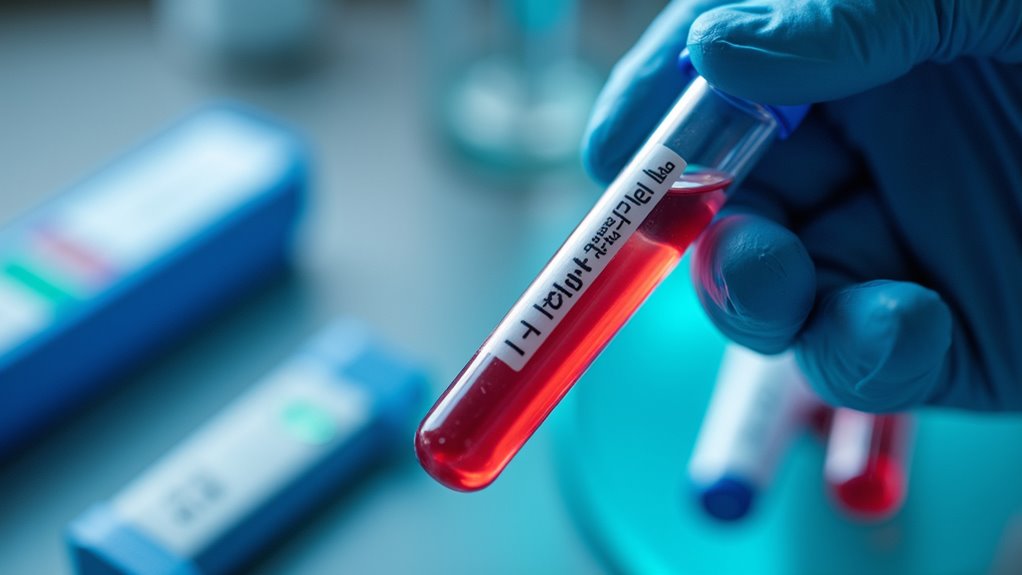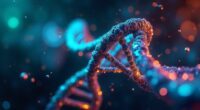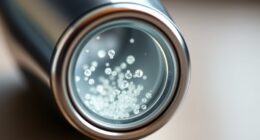PCR and antigen tests detect COVID-19 using different chemistry. PCR tests identify viral RNA by converting it into DNA and amplifying it through thermal cycling, making them very sensitive. Antigen tests look for viral proteins using biochemical reactions on a test strip, providing quick results. While PCR is more accurate, antigen tests are faster and easier to use. To understand how these methods work at the molecular level, keep exploring the details below.
Key Takeaways
- PCR tests detect viral RNA by converting it into DNA and amplifying specific genetic sequences through thermal cycling.
- Antigen tests identify viral proteins using antibody-coated particles that produce visible color changes on test strips.
- PCR tests are highly sensitive and reliable but require lab processing, while antigen tests provide quick results at the point of care.
- PCR involves steps like RNA extraction, reverse transcription, and DNA amplification; antigen tests rely on biochemical reactions on a membrane.
- Both tests target different viral components but are essential tools for COVID-19 detection, with ongoing innovations improving accuracy and speed.
How PCR Tests Detect Viral Genetic Material

How do PCR tests actually detect viral genetic material? First, they target the virus’s RNA, which needs to be converted into DNA through a process called reverse transcription. You collect a sample, often via nasal swab, saliva, or mucus. This step is crucial because RNA cannot be directly amplified by DNA polymerases. During PCR, specialized enzymes called DNA polymerases amplify specific viral DNA sequences. This process involves thermal cycling—repeated heating and cooling—to produce millions of copies of the targeted DNA. Primers and probes are used to identify the unique viral sequences, ensuring accuracy. Because PCR is highly sensitive, it can detect even tiny amounts of viral genetic material present in your sample. The entire process allows for quick, reliable detection, making it a powerful tool for early diagnosis of COVID-19. Additionally, the specificity of primers helps distinguish SARS-CoV-2 from other viruses, enhancing the test’s reliability.
The Biochemical Process Behind Antigen Tests
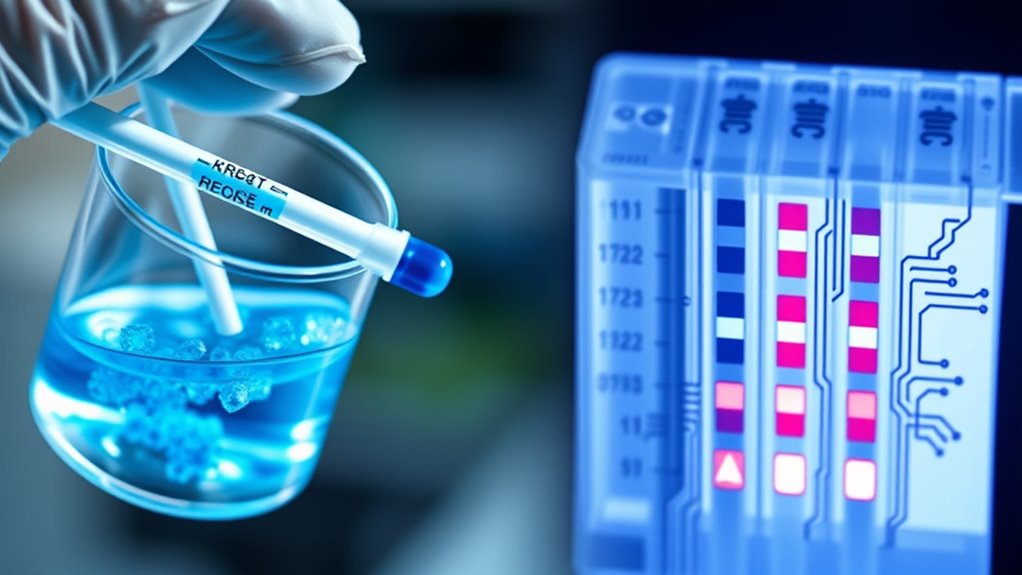
Antigen tests identify the presence of viral proteins by leveraging specific biochemical reactions on a specially designed test strip. When you insert a nasal or nasopharyngeal swab into the test, the sample migrates upward through capillary action on a porous membrane. If SARS-CoV-2 antigens are present, they bind to antibody-coated particles, like gold nanoparticles, forming complexes. These complexes then travel to the test line, where they’re captured by immobilized antibodies, causing a visible color change—usually a line—indicating a positive result. The high affinity between antibodies and antigens ensures efficient detection. The entire process is quick, often taking just minutes, thanks to the chromatographic immunoassay format. Proper sample collection and handling are essential for accurate, reliable results. Buffer pH stability is crucial to maintaining test accuracy and preventing false positives or negatives.
Comparing Accuracy and Sensitivity of Both Tests

Are PCR tests and antigen tests are less sensitive, especially early or late in infection. Their overall sensitivity is around 47%, but peaks at about 80% when viral culture is used as a reference. They perform best roughly three days after symptom onset and struggle with low viral loads. While both tests have high specificity, false negatives are more common with antigen tests, which can delay diagnosis. PCR testing provides more reliable results, especially for confirming cases, but antigen tests offer rapid results with acceptable accuracy in certain situations. Additionally, test sensitivity can vary depending on factors such as the timing of the test and the quality of sample collection.
Speed and Ease of Using PCR Versus Antigen Tests

When choosing between PCR and antigen tests, speed and ease of use play a crucial role. Antigen tests deliver results in 15 to 30 minutes, making them ideal for quick screening. They’re simple to use, often as ready-to-go kits, and don’t require lab equipment or trained personnel. In contrast, PCR tests need laboratory processing, which can take several hours to a few days, due to complex steps like RNA extraction and amplification. PCR testing involves sophisticated equipment and sample transportation, making it less accessible for immediate results. PCR tests are considered the gold standard for accuracy because they detect viral genetic material directly, providing reliable confirmation of infection. The simplicity of antigen tests makes them well-suited for at-home testing and point-of-care settings, enabling rapid decision-making. Overall, antigen tests offer a faster, easier alternative, suitable for widespread, frequent testing, while PCR remains the more detailed, laboratory-based option.
Practical Applications and Limitations in COVID-19 Testing
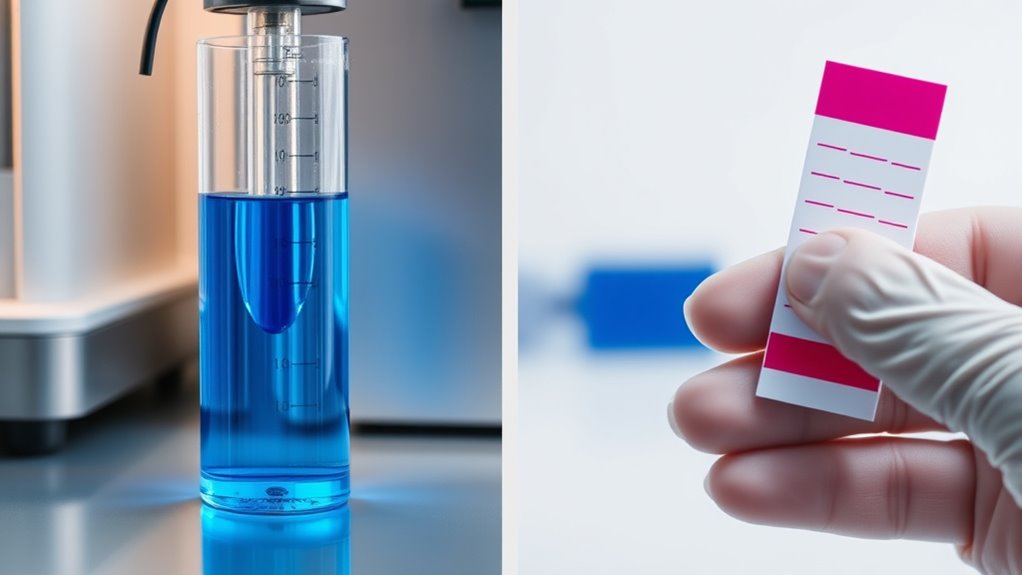
PCR tests are mainly used in clinical settings such as laboratories and hospitals because they require specialized equipment and trained personnel. They’re the go-to for confirming infection, especially in symptomatic patients or high-risk environments. However, their longer turnaround time can delay critical decisions. Antigen tests are favored for quick results at the point of care or at home, making them ideal for mass screening, but they’re less sensitive, risking False negatives, especially in asymptomatic cases or early infection stages. The table below highlights their emotional impact:
| PCR Tests | Antigen Tests |
|---|---|
| Reliable, accurate, but slow | Fast, convenient, but less sensitive |
| Detect early infections with high precision | Good for quick screening, but risk misses |
| Ideal for hospitals and labs | Useful in schools, workplaces, at home |
Additionally, ongoing advancements in automated testing methods aim to improve the speed and accuracy of COVID-19 diagnostics.
Future Innovations in COVID-19 Diagnostic Technologies

Advancements in diagnostic technologies are shaping the future of COVID-19 detection, offering faster, more accurate, and versatile options. Genomic sequencing, especially next-generation sequencing (NGS), now allows rapid, cost-effective analysis of viral genomes, helping track variants and monitor mutations in real time. Improved chemistry reduces errors, ensuring reliable data for public health decisions. Telemedicine and digital health tools also facilitate remote interpretation of test results, increasing accessibility. AI-driven tools predict outbreaks, automate workflows, and model disease trends, enhancing response strategies. Rapid testing is evolving with home-based antigen tests, multiplex assays, and biosensor innovations, making testing more accessible and scalable. CRISPR-based diagnostics deliver quick, sensitive results suitable for field use, while in vitro diagnostic miniaturization creates portable, connected devices for point-of-care testing. Additionally, ongoing research into contrast ratios and color accuracy enhances imaging techniques, which could improve diagnostic imaging and visualization in medical applications. These innovations promise a more adaptable, efficient approach to managing COVID-19 and future pandemics.
Frequently Asked Questions
How Do Sample Collection Techniques Differ Between PCR and Antigen Tests?
You should know that PCR tests typically require deep nasopharyngeal swabs collected by trained professionals, which are more invasive but offer higher sensitivity.
In contrast, antigen tests often use less invasive anterior nasal swabs or saliva samples that you can self-collect. While easier and more comfortable, these methods may be less sensitive, especially if not performed correctly, which can lead to false negatives.
Can Antigen Tests Detect New COVID-19 Variants Effectively?
Back in the day, you’d think all tests would struggle with new COVID-19 variants, but antigen tests actually detect them quite well. You can rely on them to identify recent variants like Delta and Omicron because they target conserved viral proteins.
While future mutations might pose challenges, ongoing monitoring and updates help keep these tests effective, ensuring you get quick and accurate results in your ongoing fight against the virus.
Are There Risks of Cross-Reactivity With Other Viruses in These Tests?
You should be aware that cross-reactivity can pose risks in antigen tests, leading to false positives when other viruses like rhinovirus, influenza, or common coronaviruses are present.
These tests may mistake similar viral proteins for SARS-CoV-2, especially with pre-existing antibodies or structural similarities. To minimize this, rely on tests designed with high specificity, but remember that cross-reactivity remains a potential factor affecting accuracy.
How Do False Positives Impact Public Health Decisions?
False positives can profoundly skew public health decisions by inflating case numbers and triggering unnecessary interventions.
You might see unwarranted lockdowns, resource misallocation, or delayed care for non-infected individuals. This overestimation also affects policy, leading to stricter measures in low-prevalence areas and eroding public trust.
To prevent this, you should rely on confirmatory testing, adjust protocols based on local data, and interpret results within their clinical context.
What Are the Costs Associated With Each Testing Method?
You want to know the costs of different COVID-19 tests. PCR tests range from $25 to $300 without insurance, while antigen tests are typically around $42.
At-home tests cost about $11 each, and testing at clinics like MinuteClinic costs around $70.
Your expenses depend on the test type, location, and insurance coverage, with options available for free for some groups, ensuring access regardless of your financial situation.
Conclusion
Just like a lighthouse guides ships through storms, understanding PCR and antigen tests helps you navigate COVID-19’s uncertainties. Recognize their strengths and limits, and you’ll be better prepared to make informed decisions—whether it’s catching the wave early or riding out the storm. As science continues to evolve, so will your knowledge, lighting the path toward safer days ahead. Stay informed, stay vigilant, and let clarity be your compass in these testing times.
